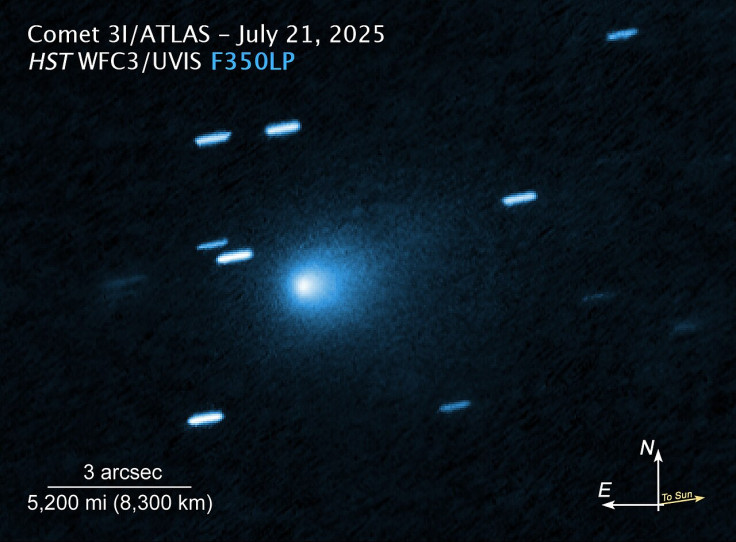Interstellar Comet 3i Atlas Size, Shape And Speed Speculated As Alien Aircraft? Scientists Admit Heavenly Body From 'Mysterious' Part Of The Milky Way
3I/ATLAS, spotted by the ATLAS survey in July 2025, is the fastest interstellar object ever recorded

The interstellar comet 3I/ATLAS, racing through our solar system at unprecedented speeds, has ignited a fascinating debate among scientists, researchers and space enthusiasts alike. With its unusual size, shape, and trajectory, some wonder whether this cosmic visitor is not a natural heavenly body at all, but an alien spacecraft in disguise.
As fresh data from NASA missions pour in, the discussion only deepens on whether 3I/ATLAS is a sign of extraterrestrial technology or an ancient wanderer from distant stars.
Unravelling the Size and Shape of 3I/ATLAS
Observations from NASA's Hubble Space Telescope on 21 July 2025 revealed 3I/ATLAS as a teardrop-shaped comet surrounded by a cocoon of dust with a solid, icy nucleus. The nucleus itself measures between 320 metres and 5.6 kilometres in diameter, a tighter range than earlier ground-based estimates. This size places it in the larger end of known comets, yet its shape remains consistent with typical cometary behaviour, influenced by solar heating that ejects dust and gas.
However, Harvard astrophysicist Avi Loeb has flagged seven anomalies in the comet's size, composition and appearance, which may hint that it could be artificial. For example, images from the Hubble and ground-based telescopes show an elongated stripe trailing behind the comet, though experts believe this could be an imaging artefact rather than part of its true form.
These findings continue to fuel ongoing analysis of its physical properties.
Speed and Trajectory: A Record-Breaking Visitor
3I/ATLAS is the fastest object ever recorded within our solar system, moving at 137,000 miles per hour or 61 kilometres per second, confirming its interstellar origin. Its hyperbolic path saw it pass within 29 million kilometres of Mars on 3 October 2025.
It will reach perihelion on 30 October 2025, at 1.4 astronomical units from the Sun, before approaching Jupiter on 16 March 2026. According to calculations, the likelihood of such a trajectory occurring naturally is less than one-in-a-million. Its velocity suggests a long and potentially ancient journey through the Milky Way.
Given its speed and the uniqueness of its trajectory, 3I/ATLAS is a prime target for future studies by Mars and Jupiter space probes.
Mysterious Origin and Alien Speculation
Comet 3I/ATLAS was discovered on 1 July 2025 by the Asteroid Terrestrial-impact Last Alert System (ATLAS) survey, a NASA-funded program designed to detect potentially hazardous asteroids and comets.
A 2025 study traced its origins to the border of the Milky Way's thin and thick disks, a mysterious region populated by ancient stars, estimating its age at 7.6 to 14 billion years. Xabier Pérez-Couto, the study's lead author, stated, 'We have found that none of the stars in the solar neighbourhood can explain the trajectory and high velocity of 3I/ATLAS.'
Some speculate that its mass exceeds 33 billion tonnes, far beyond typical comets, prompting Avi Loeb to comment, 'If the trajectory of 3I/ATLAS was designed by extraterrestrial intelligence, why is it inclined by about 5 degrees relative to the ecliptic plane?' Science communicator Matt Beall quoted Loeb on 5 August 2025, 'Harvard astrophysicist Avi Loeb says interstellar object 3I/ATLAS may be artificial' due to unlikely flybys and the absence of clear outgassing.
Harvard astrophysicist & MB Limitless guest Avi Loeb says interstellar object 3I/ATLAS may be artificial. Here’s why:
— Matt Beall (@MBeallX) August 5, 2025
1.Unlikely trajectory
It travels within 5° of Earth’s orbital plane (less than a 0.2% chance of occurring randomly)
2.Planetary flybys
It’s on a path that… pic.twitter.com/Vc6lxRRSYw
While most scientists favour a natural explanation, these anomalies continue to fuel theories that 3I/ATLAS might be more than just a celestial body. With its unique characteristics, the comet is sure to remain as one of the most intriguing objects ever observed in our solar system.
© Copyright IBTimes 2025. All rights reserved.




















